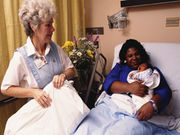Application of warm compresses to perineum during pushing, reduction in episiotomy recommended
FRIDAY, June 24, 2016 (HealthDay News) — Recommendations have been developed for the prevention and repair of obstetric lacerations during vaginal delivery. The new Practice Bulletin was published in the July issue of Obstetrics & Gynecology.
Noting that 53 to 79 percent of women will sustain some type of laceration at vaginal delivery, Sara Cichowski, M.D., and Rebecca Rogers, M.D., from the University of New Mexico in Albuquerque, reviewed the current evidence on treating lacerations and developed evidence-based recommendations for the prevention, identification, and repair of lacerations.
The authors note that strategies to reduce perineal trauma include maternal perineal massage, manual perineal support, warm compresses, different birthing positions, and delayed pushing. Based on good and consistent evidence, application of warm compresses to the perineum during pushing can reduce the risk of perineal trauma. The current data are insufficient for defining indications for episiotomy; based on the existing evidence, the decision to perform episiotomy should be founded on clinical considerations. Restrictive use of episiotomy is recommended. End-to-end and overlap repair are both acceptable for full-thickness external anal sphincter lacerations. In the setting of obstetric anal sphincter injuries, a single dose of antibiotics is recommended at the time of repair.
“We also want to ensure that obstetrician-gynecologists are taking an evidence-based approach to treating lacerations and performing episiotomy,” Rogers said in a statement.
Full Text (subscription or payment may be required)
Copyright © 2016 HealthDay. All rights reserved.








